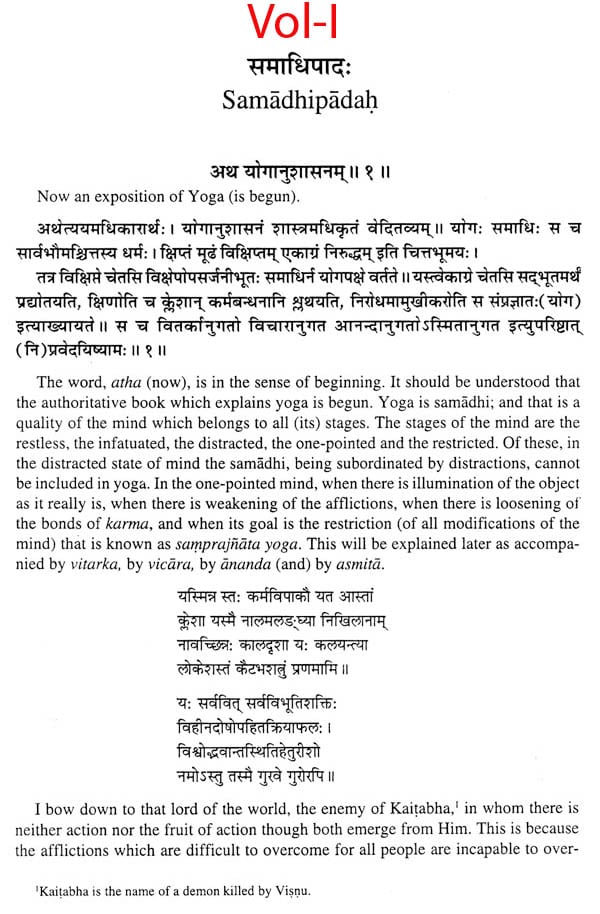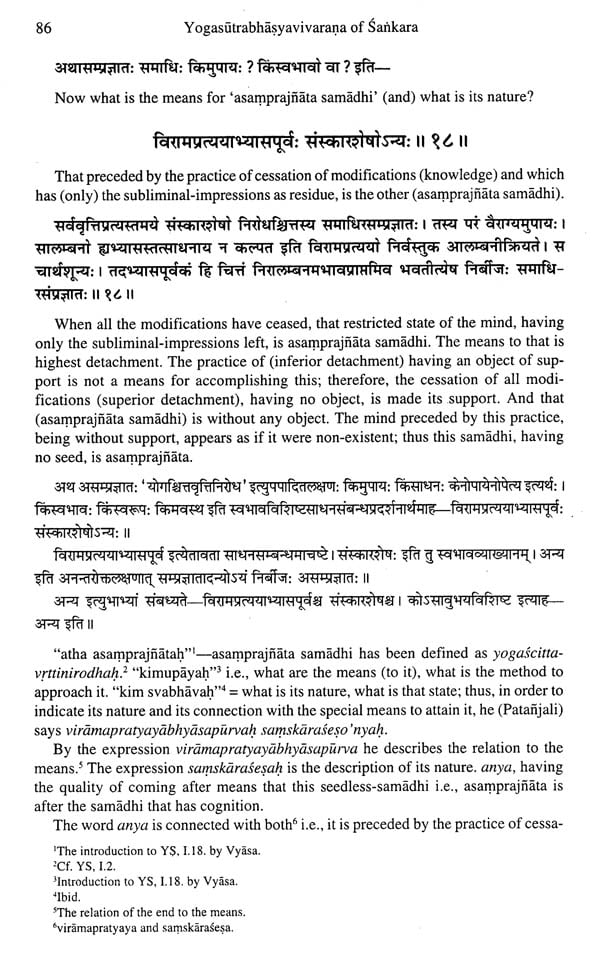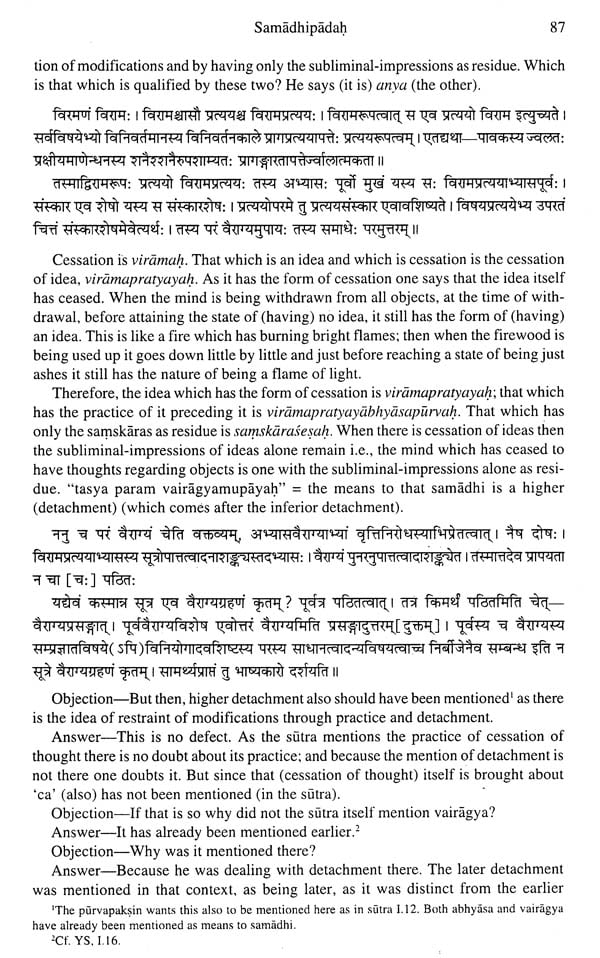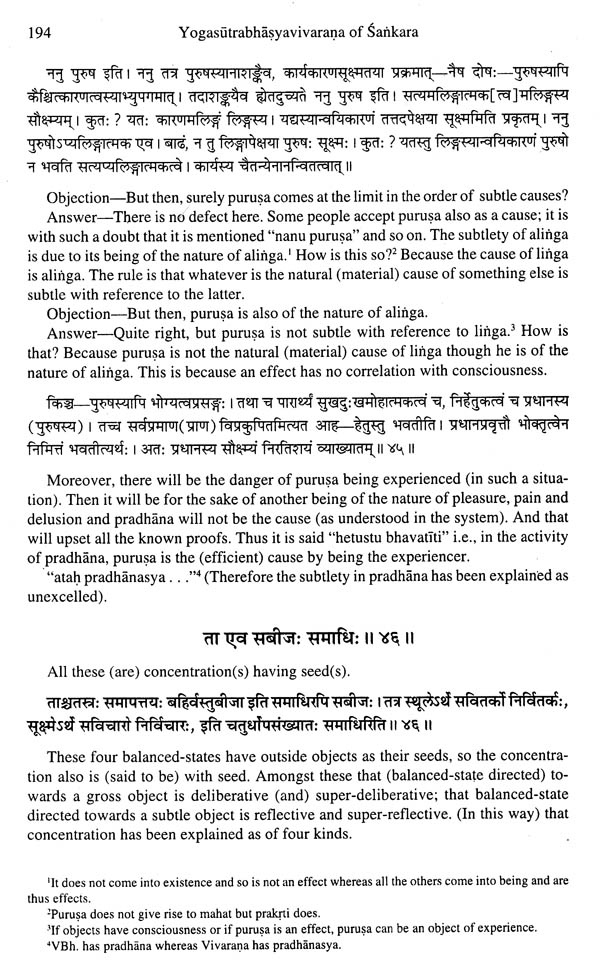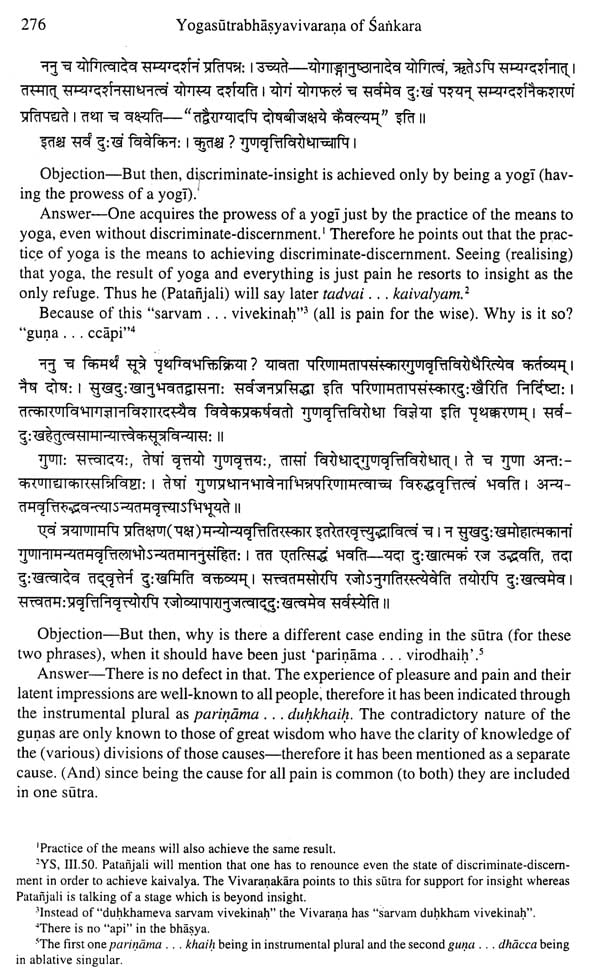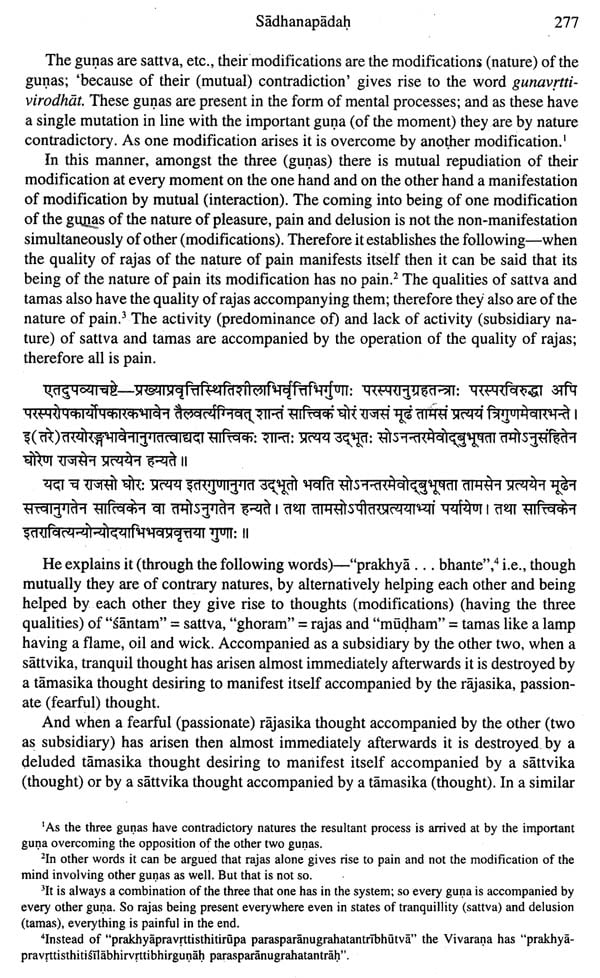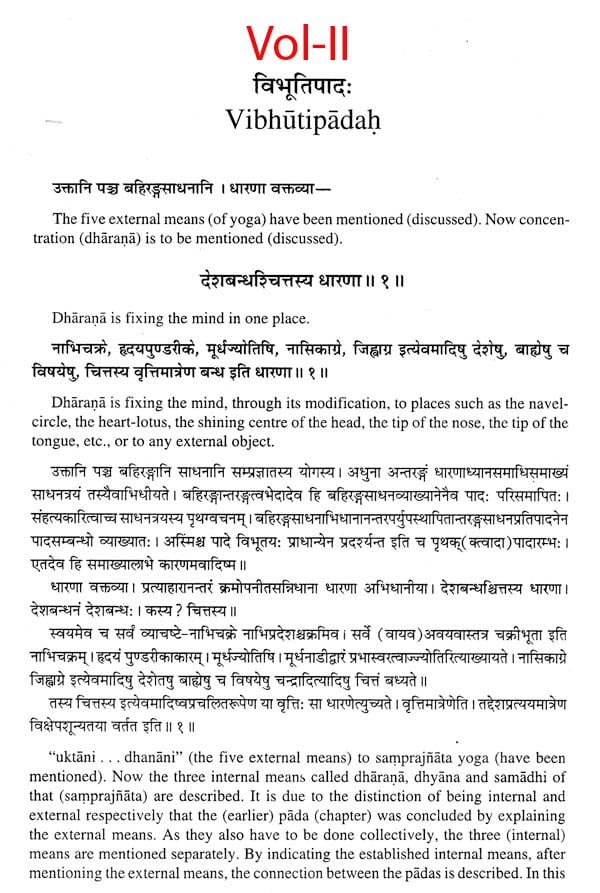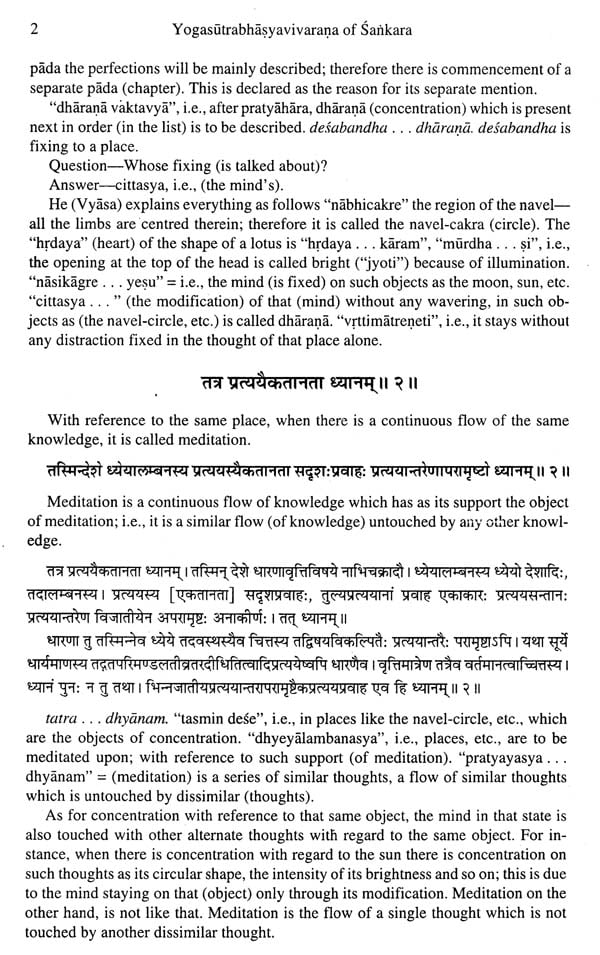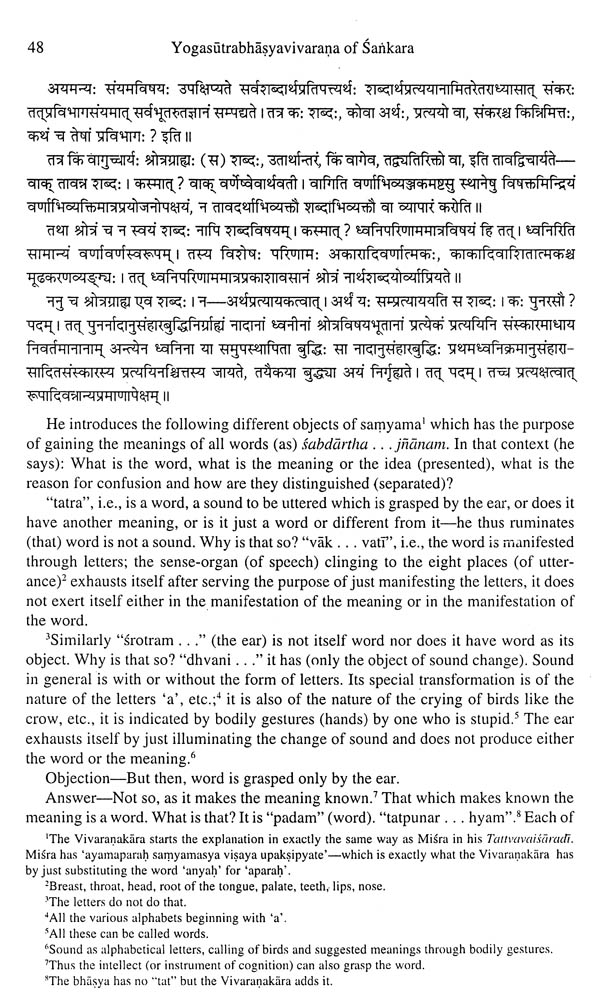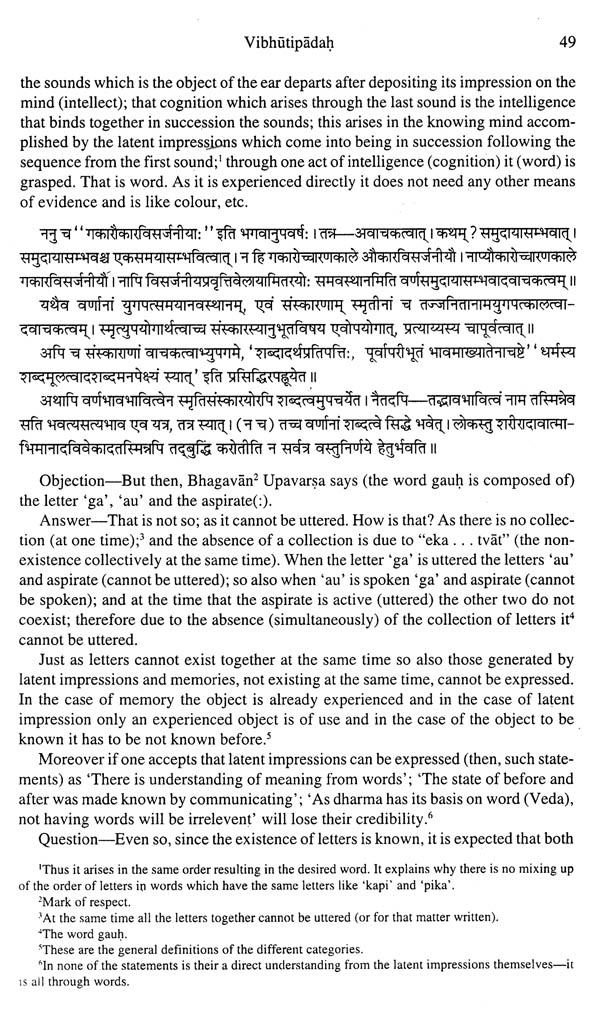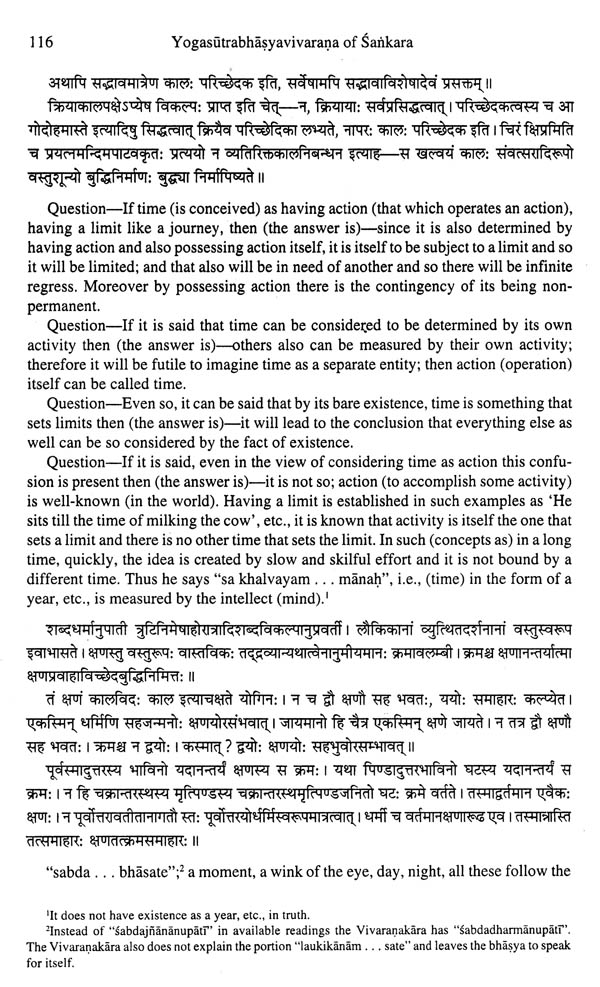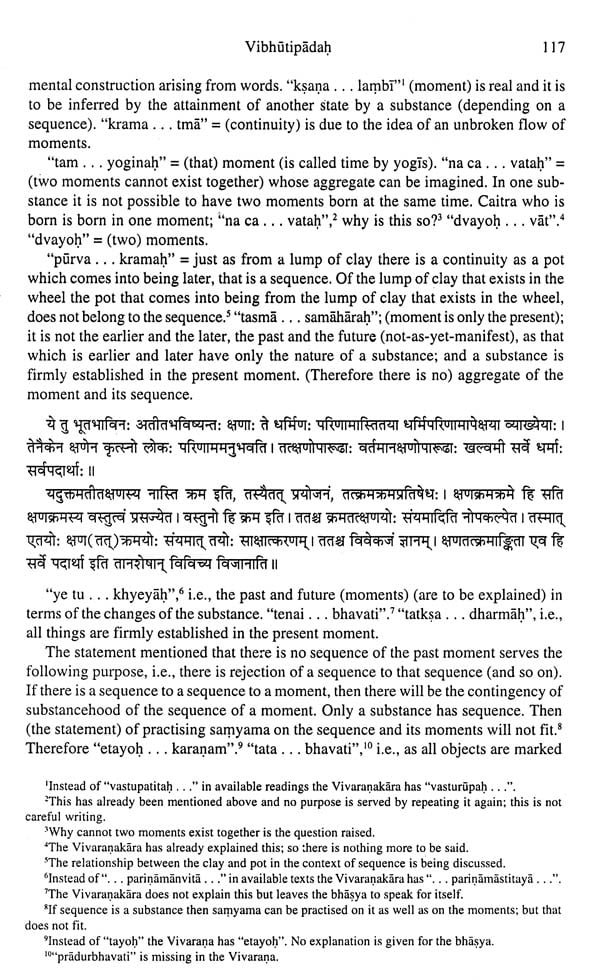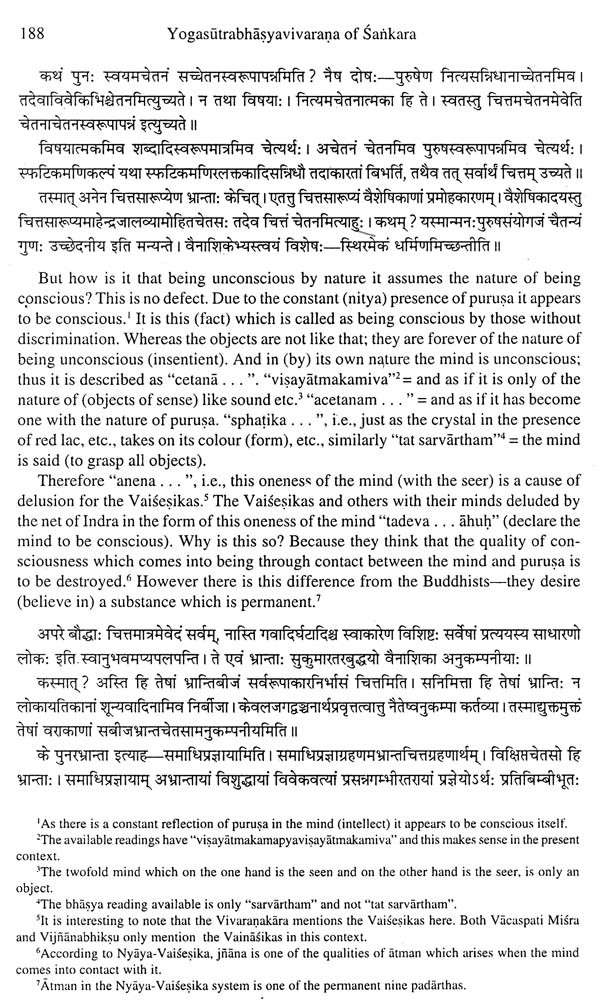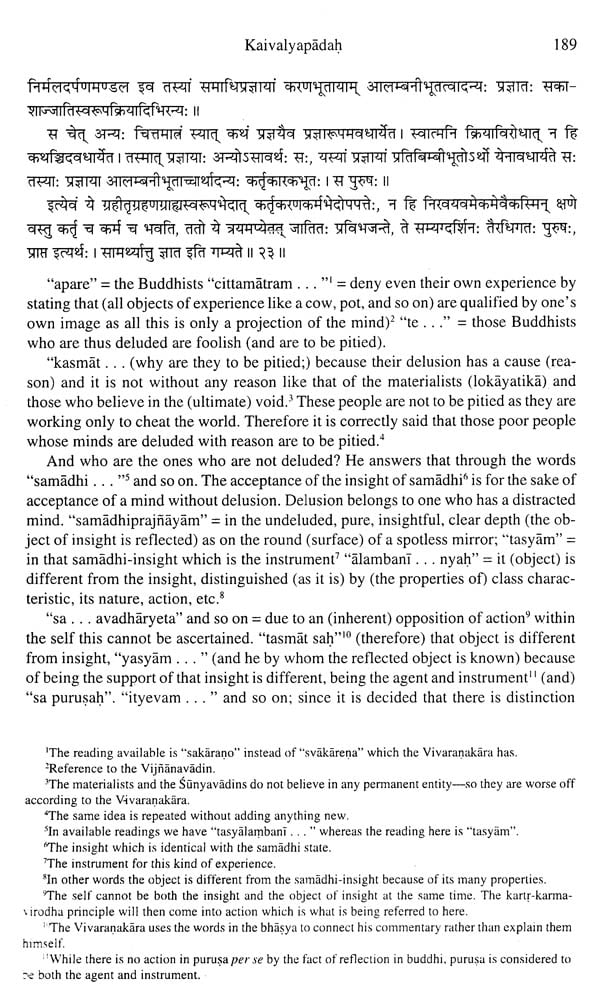
Yogasutrabhasyavivarana of Sankara (Shankaracharya) (2 vols.)
Book Specification
| Item Code: | IDC109 |
| Author: | T.S. Rukmani |
| Publisher: | MUNSHIRAM MANOHARLAL PUBLISHERS PVT LTD |
| Language: | English |
| Edition: | 2018 |
| ISBN: | 9788121509084 |
| Pages: | vol1: 432, vol2: 242 |
| Cover: | Hardcover |
| Other Details | 6.6" x 10.2 |
Book Description
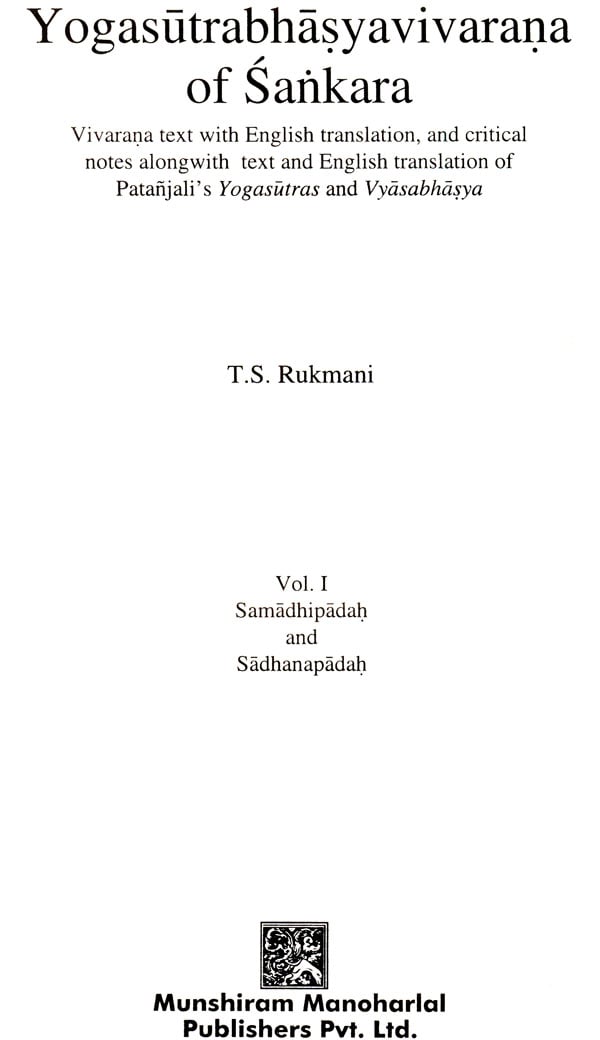
Volume I
From the Jacket
In this two-volume work of critically translating the Yogasutrabhasyavivarana (YSBHV) of Sankara, the Yogasutras of Patanjali, and the bhasya of Vyasa, all these three texts have been brought together for the first time. The question of the authorship of YSBHV has been a vexed one and has engaged the attention of scholars for a long time. In this work the authorship problem has been examined in great detail on the basis of both the internal and external evidences. The author has also drawn attention to some specific references to Vacaspati Misra in the body of the Vivarana. This, hopefully, should settle once and for all the authorship problem.
Dr. T S. Rukmani is currently Professor and in Hindu Studies at Concordia University, Montreal. Canada. Before joining the present assignment she had the distinction of being the first Chair in Hindu Studies and Indian Philosophy at the University of Durban-Westville, South Africa. She had a distinguished academic career at the University of Delhi, where her last assignment was Principal, Miranda House. She is the author of ten books which also includes the Yogavarttika of VQ1i§.nabhiksu, translated into English, 4 vols. (New Delhi, 1981-89). She has innumerable papers to her credit and publishes regularly in academic journals both in India and abroad.
The Yogasutrabhasyavivarana (YSBHV)—An annotated critical English translation, the research project for which I was given a fellowship at the Indian Institute of Advanced Study, Shimla, India in 1989-90. At that time I was not aware of Trevor Leggett translating the same work. When I had completed the Samadhipada in 1990. Leggett’s Samadhipada translation came to my notice. But seeing the divergent approach of that translation from what I was doing, I decided to continue the work. Thus in spite of moving residences and jobs in the interim period (first to South Africa and then to Canada) I kept doggedly on and now it is ready at last.
A number of my friends and colleagues have helped me in many ways in this work and I thank them all for their support. I would, however, like to specially mention Dr. C.S. Radhakrishnan of the Vivekananda College, Madras, India, who was instrumental in procuring some important Sanskrit material, without which this research would rave been incomplete.
I take this opportunity to thank Kluwer Academic Publishers for allowing me the use of my published articles in their journals. With their kind permission I have used material published earlier in their Journal of Indian Philosophy, vols. 20, 1992, pp. 105-9, and 2l, 1993, pp. 395-404 titled ‘The Problem of the Authorship of Yogasutrabhasyavivarana’ and ‘Sankara’s views on Yoga in the Brahma- sutrabhasya in the light of the authorship of the Yogasutrabhasyavivarana respectively.
My husband S. Rajamani, has been of immense support throughout this period of hard work and also helped in the preparation of the Index. I would like to record my appreciation for all his understanding and support.
I dedicate this two-volume enterprise to my dear, departed parents. My mother, N. S Parvathy, stood by me as a solid example of what women can achieve in spite of the great odds they are faced with. My father, T.V. Subramaniam, sowed the seeds of curiosity and questioning in my mind and was primarily responsible for my taking up Sanskrit studies.
Finally I would like to thank my Publisher Mr. Devendra Jain who exerted pres- sure on me to complete the work and brought it out in record time.
Let me begin the introduction by pointing out how this two-volume work on the Yogasutrabhasyavivarana (YSBHV) differs from the translation that Trevor Leggett had done of the same book (1992). Firstly this has all the three texts——the sutras of Patanjali, the bhasya of Vyasa and the Vivarana of the Vivaranakara (VK). Thus following the format of my earlier work, the Yogavarttika of Vijnanabhiksu, the sutra text is printed in 14 point black, the bhasya in 12 point black and the Vivarana text in 12 point white. I have used the single text of the YSBHV published in the Madras Government Oriental Series no. 94 in 1952 edited by Sri P.S. Rama Sastri and Sri S R. Krishnamurti Sastri for this work. I have kept the readings in this text as they are, including what is in brackets. While translating the YSBHV, I have used whichever reading fits into the context better. No attempt has been made to arrive at a standard edition of the YSBHV text. I have not attempted a fresh translation of the sutra and bhasya texts but have used my earlier translations in the Yogavarttika, with necessary changes, whenever the readings were different. I have tried to divide the passages both in the bhasya and in the YSBHV keeping the trend of the arguments unbroken. In the body of the work the sutra texts have been indicated by italics and the bhasya eats can be recognised by double inverted commas. Very often I have not attempted to translate well-known Sanskrit words.
I have mentioned in the preface how I got to know of Leggett’s translation only after completing the first Samadhipada. But now that the whole translation of Leggett’s work is available I would like to point out how this two-volume work on the same text differs from it, in many ways.
The advantage of having the sutra, bhasya and YSBHV in one place is obvious to anyone who wants to consult them. The many positive responses I have had for my Yogavarttika (YV) translation, which followed the same pattern, has encouraged me to stick to that format in this work as well.
I have seen the exhaustive notes by Tuvia Gelblum on Leggett’s translation in the Bulletin of the School of Oriental and African Studies and the interested reader can refer to it for further information. Gelblum has drawn attention to many points and has also addressed the question of authorship of the YSBHV. While I agree basically with what Gelblum has to say, there are also some additional points to which I would like to refer. I shall touch upon some, which are of special importance to my mind.
Gelblum makes some observations on the word varta in sutra III.36 and the manner in which Leggett has glossed over it? He has ably refuted Leggett’s attempt to give a fanciful interpretation to varta. Gelblum points out Bhoja’s explanation of varta as also the occurrence of the word varta in the Siva Purana which is quoted by al-Biruni in the eleventh century AD. He has rightly said that Vacaspati Misra (Misra) could not have known of the reading atitasya in place of vartamanasya in the bhasya text of III.l4 and infers that the Vivaranakara (VK) must therefore be later than Misra. As Vijnanabhiksu (Bhiksu) makes the Same Correction as the VK, it supports what Gelblum says though he (Gelblum) does not seem to know of it. On the basis of his interpretation of YS, lV.34, Gelblum also argues for the VK being later than Bhoja (eleventh century AD).
I would add a few more observations on Leggett’s work both with regard to style and content. First and foremost Leggett has a tendency to read more than what is there in the text. Thus under sutra I.7 talking about anumana (inference) and the invariable relationship between two things, the VK uses two words vadhya (hunted) and ghataka (hunter) in a general sense. But Leggett translates them specifically as cat (ghataka) and mouse (vadhya) throughout the passage, without giving any explanation as to why he is doing so.
Similarly Leggett attaches too much importance to the word Paramesvara under sutra ll.46 making it appear as if that alone denotes the Lord of all (a literal translation) and implies that somehow the Isvara of Yoga is limited. I cannot understand how the Yoga Isvara is limited when the set of sutras 1.23-29 clearly define him as unlimited. This salutation to an Almighty God would, if anything, make the YSBHV contrary to what Leggett says, not the work of Sankara. Sankara`s commentary on , the Gita makes a bhakta surrender his everything to Isvara in a sense of samnyasa and that is the salutation which he very often advocates in his Gitabhasya. The very, word Parmesvara is glossed over as atma in the Gita in many places.
Leggett also has the tendency to make definitive statements like “Sankara makes samadhi one of the necessary means to release."“ This is not quite what Sankara is saying and I have dealt with it in my paper on Sankara and Yoga (see appendix II to vol. II of this work). In citing Upadesasahasri (UPA) l.l9.2 anti glossing ‘others’ as yogin-s and then inferring that there is a direct reference to YS, lll.35 here, is again misleading? The word ‘others’ is translated as Sankhya-s by Anandagiri and others. Mayeda accepts this translation and says ‘All commentaries consider this the view of the Sankhya and interpret para as ‘purusa’." Thus Leggett’s statement is not correct. In many places Leggett also freely translates the YSBHV without being faithful to the text. This is seen especially in the portion dealing with the Isvarakaranavada (I, 25) and the sutra on sabda (III.l7). Leggett almost suggests that Sankara the BSBH author consciously wrote the YSBHV in order to replace with Vedantic views the belief in the "plurality of separate purusa-s and the conscious pradhana as source of the world" which are the Yoga views he criticizes in the Y0gaprazyuktapmkarana.‘ Leggett is also not always faithful to the text in his translation (see later). All this gives the impression that Leggett’s translation seems to address itself to the general reader.
Leggett finds similes used by the VK, "brilliant" and in his judgement "original" contributions of the VK.2 l would like to look at some of his examples in a different way. For instance the statement in the YSBHV that an "expert’s estimate of a gold’s weight by merely looking at it" can be compared to a similar statement in the Vakyapadiya about an expert’s knowledge of the genuineness of precious stones and gems born of practice.3 So also, sensory perceptions leaving their impressions, is only a variation of modifications taking on the shape of the objects, like liquid copper placed in a crucible; mudra and pratimudra are just the same imagery as bimba and pratibimba which are widely used in Hindu thought. As for the equality theory is it not already there in the bhasya of Vyasa?
The greatest shortcoming of Leggett’s work is the lack of an index which makes it almost inaccessible to all but the one who already knows the Yoga school well enough to know where to look for the information sought. Thus, while on the one hand the work seems to have the general reader in mind, on the other, not having an index, makes it useful only for a scholar of Yoga. And the shortcomings that the work has for Yoga—scholar has already been touched upon.
Volume II
This second volume of the Y0gasZ¢tmb/tcisyavivammz (YSBHV) is being published almost immediately after the first volume of the YSBHV. There is nothing new that I have to say regarding this volume. I would, however, like to remember all those who have helped me in many ways in the writing and completion of this two-volume work and thank them for it.
I once again dedicate this work to my dear, departed parents, Srimati N.S. Parvathy and Sri TV. Subramaniam.
The introduction to volume I of the Yogasutrabhasyavivarana (YSBHV) deals in great detail with the question of the authorship of the YSBI-IV and the general con- tents of the entire Vivarana. The interested reader can consult that for those specific details. As the authorship question is an important one plaguing scholars for a long time I would also like to state here, in brief, the conclusion I have reached, based on internal and external evidence, i.e., that the YSBHV is not the work of Sankara the author of the Brahmasutrabhasya (BSBH). Based on a line by line reading of the YSBHV I feel confident to state that the Sankara who wrote the Vivarana is certainly not the BSBH author. The style and the contents of the work also lead me to conclude that the author of the YSBHV, who I believe is from Kerala, lived after the twelfth century of the Common Era. Because of some of the references to the Vivarana in the Gapalika of Paramesvara II who belonged to the Payyur Bhatta family of Kerala, he could not have lived later than the fifteenth century of the Common Era. Thus a Sankara who lived anywhere between the twelfth and the fifteenth centuries of the Common Era could have written this great work in the field of Yoga.
As for the style, the same format followed in the first volume has been kept in this volume as well. The sutra, bhasya and Vivarana of the Vibhutipada and Kaivalyapada are all brought together in this second volume as was done in the case of the Samadhipada and Sadhanapada in the first volume. The sutra text is printed in l4 point black. The bhasya in l2 point black and the Vivarana text in l2 point white. I have used the single text of the Vivarana published by the Madras Government Oriental Series no. 94 in 1952, edited by Sri P.S. Rama Sastri and Sri S.R. Krishnamurti Sastri for this work. I have not attempted a fresh translation of the sutra and bhasya texts but have used my earlier translations in the Yogavarttika (Rukmani, Yagavarttika, vols. I-IV, 1980, l983, l987. 1989) with necessary changes, whenever the readings were different. I have, as in volume I, tried to divide the passages both in the bhasya and the Vivarana keeping the trend of the arguments unbroken. In the body of the work the sutra texts have been indicated by italics and the bhasya texts can be recognised by double inverted commas. Very often I have not attempted to translate well- known Sanskrit words.
While general comments on the YSBHV as a whole have already been given in the introduction to vol. I, I shall just add a few observances from the Vivarana commentary on the Vibhutipada and Kaivalyapada, which form the contents of vol. II. Thus, there is hardly any quotation from sruti or smrti texts that the author uses to further his points in these two padas. The only exceptions arc some verses from Kumarilabhatta’s Slokavarttika under III.17 and a couple of other quotes in the Vibhutipada. The Kaivalyapada—Vivarana has just one quote from the Bhagavad-Gita under IV.10. When one looks at the other commentators like Vacaspati Misra and Vijnanabhiksu who, like the Vivarana-Sankara, wrote commentaries on the Vyasabhasya, one cannot but notice the lack of references to sruti and smrti texts in the Vivarana.
Another feature of the Vivarana is that the author avoids or is not forthcoming with any attempt to interpret the bhasya text. Thus opportunities for different interpretation under Hl.45, IV.4, etc., are not fully exploited by the Vivarana author. He is content with repeating verbatim the bhasya-explanation in most of the cases. These are far too many to be mentioned here but they are pointed out in the notes under every sutra-bhasya-vivarana and the interested reader can refer to them in the body of the work. Using the sutra and bhasya given in this edition of the YSBHV the variant readings in the Vivarana have also been pointed out in the notes in the body of the work, The Vivarana author has a monotonous, repetitive style which sometimes jars on the reader. One can refer to the Vivarana under lll.l3, 15. 17, 45 et seq.
It must not be concluded from what has been stated above that the Vibhutipada and Kaivalyapada of the Vivarana are without any merit. There are places where the author comes up with interesting observations. Thus under IV.7, for instance, he ridicules the belief in the result of expiatory deeds and again under lV.26 he singles out aparigraha for a pride of place amongst the ethical virtues. His summary of the various views on kaivalya under IV.34 is very elucidating.
I will conclude this brief introduction by repeating what I have already said in the introduction to the first volume. "We cannot quarrel with the contents of the YSBHV in which the Vivaranakara passes with flying colours. But it is his style and the manner of writing, that put one off and which cannot place him in the same category as the HSBH author.
| Abbreviations | vi | |
| Preface | vii | |
| Introduction | ix | |
| Samadhipadah | 1 | |
| Sadhanapadah | 205 | |
| Bibliography | 379 | |
| Index | 381 | |
| | ||
| Abbreviations | vi | |
| Preface | vii | |
| Introduction | ix | |
| Vibhutipadah | 1 | |
| Kaivalyapadah | 127 | |
| Appendix I: The Problem of the Authorship of the Yogasutrabhasyavivarana | 212 | |
| Appendix II: Sankara’s views on Yoga in the Brahmasutrabhasya in the Light of the Authorship of the Yogasutrabhasyavivarana | 216 | |
| Bibliography | 223 | |
| Index | 225 |
